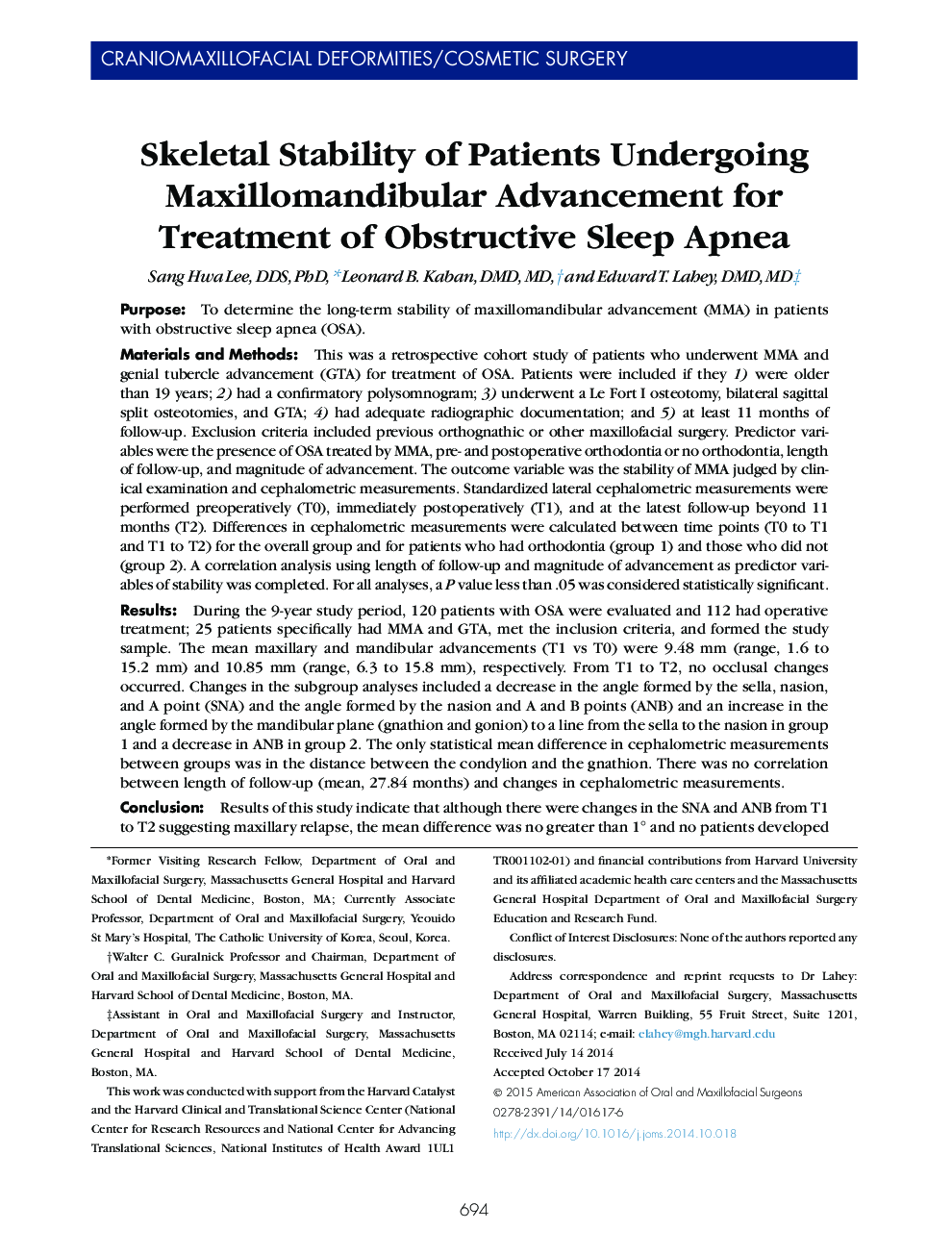| کد مقاله | کد نشریه | سال انتشار | مقاله انگلیسی | نسخه تمام متن |
|---|---|---|---|---|
| 3153150 | 1198025 | 2015 | 7 صفحه PDF | دانلود رایگان |
PurposeTo determine the long-term stability of maxillomandibular advancement (MMA) in patients with obstructive sleep apnea (OSA).Materials and MethodsThis was a retrospective cohort study of patients who underwent MMA and genial tubercle advancement (GTA) for treatment of OSA. Patients were included if they 1) were older than 19 years; 2) had a confirmatory polysomnogram; 3) underwent a Le Fort I osteotomy, bilateral sagittal split osteotomies, and GTA; 4) had adequate radiographic documentation; and 5) at least 11 months of follow-up. Exclusion criteria included previous orthognathic or other maxillofacial surgery. Predictor variables were the presence of OSA treated by MMA, pre- and postoperative orthodontia or no orthodontia, length of follow-up, and magnitude of advancement. The outcome variable was the stability of MMA judged by clinical examination and cephalometric measurements. Standardized lateral cephalometric measurements were performed preoperatively (T0), immediately postoperatively (T1), and at the latest follow-up beyond 11 months (T2). Differences in cephalometric measurements were calculated between time points (T0 to T1 and T1 to T2) for the overall group and for patients who had orthodontia (group 1) and those who did not (group 2). A correlation analysis using length of follow-up and magnitude of advancement as predictor variables of stability was completed. For all analyses, a P value less than .05 was considered statistically significant.ResultsDuring the 9-year study period, 120 patients with OSA were evaluated and 112 had operative treatment; 25 patients specifically had MMA and GTA, met the inclusion criteria, and formed the study sample. The mean maxillary and mandibular advancements (T1 vs T0) were 9.48 mm (range, 1.6 to 15.2 mm) and 10.85 mm (range, 6.3 to 15.8 mm), respectively. From T1 to T2, no occlusal changes occurred. Changes in the subgroup analyses included a decrease in the angle formed by the sella, nasion, and A point (SNA) and the angle formed by the nasion and A and B points (ANB) and an increase in the angle formed by the mandibular plane (gnathion and gonion) to a line from the sella to the nasion in group 1 and a decrease in ANB in group 2. The only statistical mean difference in cephalometric measurements between groups was in the distance between the condylion and the gnathion. There was no correlation between length of follow-up (mean, 27.84 months) and changes in cephalometric measurements.ConclusionResults of this study indicate that although there were changes in the SNA and ANB from T1 to T2 suggesting maxillary relapse, the mean difference was no greater than 1° and no patients developed a malocclusion; therefore, the changes were considered clinically minor. Advancement of the maxillomandibular complex by 10 mm for treatment of OSA remains stable at a mean follow-up period longer than 2 years and preoperative orthodontic treatment does not appear to influence skeletal stability.
Journal: Journal of Oral and Maxillofacial Surgery - Volume 73, Issue 4, April 2015, Pages 694–700
